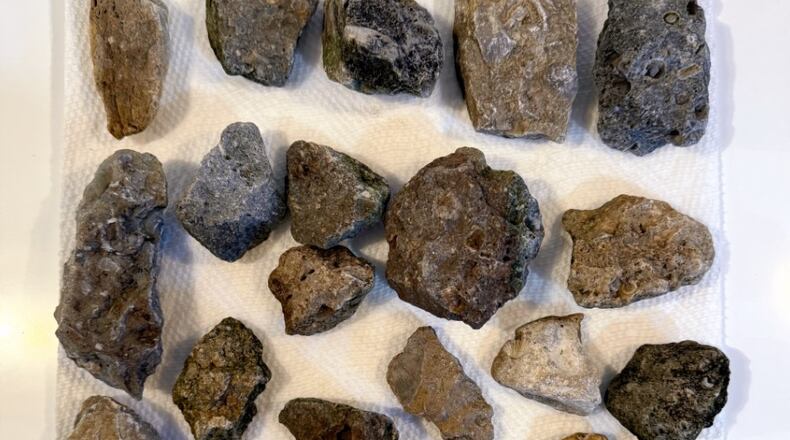The first day we were there, we didn’t find any — but we were hooked. We tried a different location the next day, the lush Fort Clinch State Park, specifically where the Amelia River dumps into the Cumberland Sound. There, we found many beachcombers.
One gave us tips on how to spot the teeth along the tide line, looking for blue-black gunmetal triangles glinting in the sun.
After several days and multiple locations, our favorite being Fort Clinch, my husband, stepkid and I walked away with more than 20 fossilized shark teeth between us.
When we returned to Ohio, I dug out the fossils I had found once on the side of the Pennsylvania Turnpike as a kid (long story short: a very significant accident led to a complete stop of traffic, and a state trooper told us all to turn off our vehicles and settle in). In the shale along Pennsylvania’s I-76, my brother and I found loads of fossils: seed ferns, brachiopods (essentially shells) and some other type of leaf. Those fossils had been in a plastic bag for more than 20 years.
I washed and air-dried them, then started researching where I could hunt for fossils in southwest Ohio. Luckily, one of the best spots happens to be in this area: Caesar Creek State Park.
A couple weekends ago, my husband, stepchild and I took a trip to Caesar Creek just to hunt for fossils. We packed a picnic lunch, and a backpack to store our finds. After about two hours, we walked away with some really great finds.
After cross-referencing my fossils with the Caesar Creek fossil brochure and my own fossil guidebook, I was able to catalog my haul: several brachiopods, gastropods, cephalopods, bryozoans and a crinoid. I was thrilled — but I’ll be back to hunt for trilobites (an ultimate on my fossil bucket list).
Happy fossil hunting.
Why is Caesar Creek State Park such a fossil hotspot?
According to FossilGuy.com (a great resource, if you’re a fossil nerd like me), there used to be an ancient reef system in this area. At one point, Ohio was underwater, covered by a shallow sea.
What kind of fossils can I find?
You can find many different fossils here in the limestone and mudstone, including brachiopods (think bivalves, like clams or oysters, as well as one-shelled beings), cephalopods (in the octopus family), bryozoans (called “moss-animals,” and they look like twigs or corals), gastropods (they look like snails), crinoids (called “sea lilies,” it was a plant-like animal), horn corals and trilobites.
How old are these fossils?
The fossils found date back to the Ordovician period, which is 449-445 million years ago.
What are the rules for fossil hunting at Caesar Creek?
- You must register for a fossil hunting permit at the Caesar Creek Visitor Center
- Hunt for fossils only in the designated areas (just north of the spillway, near the gorge – they’ll tell you exactly where at the visitor center)
- You can’t use tools or break rocks against each other
- Only take home fossils that fit in the palm of your hand
- You can’t sell the fossils you take
Where should I park?
I recommend parking in the gorge area. To get there, Take I-71 to the Wilmington Road exit, head east, then turn left onto Olive Branch Road, followed by a right onto Oregonia Road, a left onto North Clarksville Road, and finally a left onto the Caesar Creek Gorge Access Road, which leads to the Gorge Loop Trail parking area.
HOW TO GO
What: Caesar Creek State Park Visitor Center (to get permit)
Where: 4020 N. Clarksville Road, Waynesville
Cost: Free to fossil hunt
More info: 513-897-1050 | https://caesarcreekstatepark.com/
About the Author




